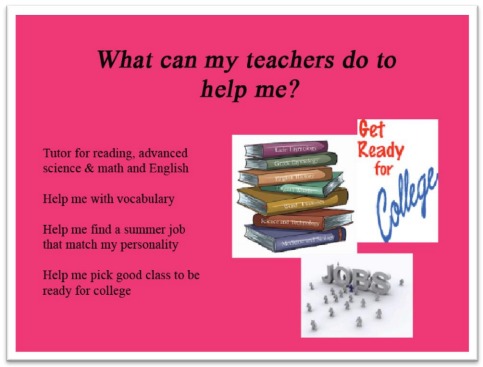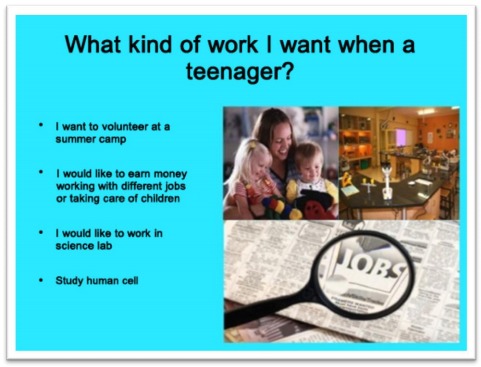<< Learning Center
Media Accessibility Information, Guidelines and Research
Expectations in Transition Meeting-Encouraging Student Participation
By Theresa Johnson, M.Ed.
Introduction
Transition planning for high school students has been going on in some formal way for over two decades within the school system. Some states set the transition age at 14, and others started the planning at age 16. In most cases, it was addressed as a separate process with its own set of paperwork from that of the Individual Education Plan developed in an IEP meeting where academic progress, classroom accommodations and other student needs were addressed. The Individuals with Disabilities Education Act (IDEA) places emphasis on the importance of the transition planning process, with clear guidelines as to how planning should take place.

Indicator #13-Transition Mandates
Each state is required to develop a State Performance plan which addresses how they will implement special education performance indicators. There are twenty indicators set by the Department of Education which each state must include in their plan. However, how they go about addressing them can be achieved in a way that is unique to the state – much like an IEP for a student! Of the twenty indicators set by the Department of Education, indicator #13 emphasizes the transition process in a comprehensive way. There are specific components of the transition planning process that are to be included in every plan with every student. These are: every student must be given age-appropriate assessments to determine vocational strengths and needs, there must be a set of measurable vocational goals, there must be a coordinated set of activities planned and implemented to assist the student in meeting his/her goals, and when appropriate, independent living goals must be addressed. IDEA also emphasizes the importance, in fact, requirement, that all students must be invited to their transition planning meeting. After all, it is their life goals which are addressed in that meeting. The coordinated set of activities must address transition goals specific to an individual student. They cannot be coordinated and complete in one school year; rather the activities should be planned, revised, refined, and replanned with each school year. This way the activities are a reflection of the current and future needs of the student and his interests. A coordinated set of activities, in most cases, will involve a number of people who will assist the student, including those who work within the school, the family, and a number of professionals from the community.
For the activities planned to lead to successful outcomes, it is essential that all parties work together in a collaborative, cohesive way. It comes as no surprise that in many instances, the collaboration is difficult to achieve due to a number of challenges.
Student-Led IEP Transition Meetings
Educators are overwhelmed with the responsibilities within the school and the classroom, and the addition of IEP meetings and transition planning can overextend them. With so many IEP meetings to complete, often they are scheduled in blocks of time where their goal is to complete each meeting within 20-30 minutes. The time required to coordinate good planning, involve the student, and hear feedback from everyone present is very time consuming. To further complicate the situation, many educators are very competent in their subject matter but have received little to no training in how to assist a student with their transition planning. Conversely, students also can be overwhelmed by the process and confused about what their career goals will be and how to navigate the many systems to obtain assistance or gain entry into a system. Parents often share the students' feeling of being overwhelmed by the process and are confused by the same issues. There are specific ways to navigate each system – all very different from the schools.
These challenges are even more complex for those families who do not use English as their primary language. Keeping these challenges in mind, there are some basic principles to adhere to by everyone who attends the IEP/Transition meeting.
Always invite the student to his/her meeting. Encourage him/her to remain in the entire meeting and participate to the best of his/her ability. Even though a meeting may generate a great deal of enthusiasm, professionals should remember to not speak over a student and work hard to give the student plenty of opportunity to express his/her opinions, preferences, and requests. Acknowledge the student's comments and respond appropriately. The meeting is a wonderful opportunity for learning. The adults in the room should take care not to miss an opportunity to explain to the student what is being discussed so that he/she has as much understanding of the discussion as is possible and ultimately can contribute to the planning of his/her life.
It would be inappropriate to assume that all the professionals in the meeting fully understand the process as well. With representatives present who may work within a different system, often they are unfamiliar with the idiosyncrasies of other systems. It is almost impossible to have meaningful discussion which will help the student if the professionals in the room do not have an understanding of each other's' systems.
A way to address this issue is to set up a meeting prior to the IEP meeting for the professionals to share other details of their system which are germane to the transition process for the student. Perhaps even a time to swap samples of paperwork, forms, and other documents which may be used, and review them for familiarity. Professionals from education, rehabilitation, independent living centers, and many others will surely have a greater impact on the success of the student if among themselves they have a shared respect, understanding, and working knowledge of their respective systems/programs.
Student Participation
There cannot be too much emphasis placed on the importance of student involvement in the transition planning process. In the true spirit of student involvement, educators and rehabilitation counselors might brainstorm with the student on strategies for achieving the maximum student participation. It is one thing to say a student should participate, but if the student is not prepared, not comfortable, or does not understand the process, participation will be limited. Teaching the student how to advocate for themselves, express preferences, and set goals and plan strategies for meeting those goals is a tall order. However, it can be done to the student's best ability with instruction and preparation before the meetings.
Also, involving the student in planning the meeting will help him/her feel invested in the success of the planning. Involvement can be as simple as creating and sending invitations to those students who would like to attend. Working one-on-one with the student to create a "cheat sheet" which can be used to guide the student during the meeting might be helpful.
A strategy implemented at the Texas School for the Deaf for some students who are not comfortable being in a meeting or who may have difficulty expressing themselves in a meeting are videos of the student talking about their goals. The student can show this as an introduction in the meeting, and planning can take place after viewing. Picture boards, to tell a story of what the student enjoys, may be a strategy for an individual with cognitive and/or language disabilities. For those students who are capable, a PowerPoint presentation can be created which the student shows while presenting to the group what his/her interests, academic needs, vocational goals, etc. are and can be easily revised from year to year.
My daughter Amy is 16 years old and is deaf. She attends the Texas School for the Deaf. Amy began attending her IEP meetings in the 2nd grade. Even though she understood little of what was being discussed in the meeting at that time, she knew the meeting was about her, and she knew it was to discuss school. By the time she was in the 5th–6th grades, Amy was able to begin freely expressing preferences, likes and dislikes, and what she thought she wanted to do when she grew up with minimal prompts. She did not necessarily enjoy the meetings—what 9 year old would enjoy sitting in a room full of adults who are talking about her? However, by the time she was in the 6th–7th grades, she was initiating conversation, discussing her class and sports preferences, and had a solid understanding of the purpose of the meeting. In the 8th grade she created her first PowerPoint presentation with minimal assistance regarding what topics she would want to address, and by the 9th grade she was able to lead 90% of the IEP transition planning meeting.
Many of our students can do this with the appropriate guidance and encouragement. The most essential part of all of this is helping the student understand that this meeting is all about him/her, and what he/she thinks is more important than what anyone else in the room has to offer.
Amy's PowerPoint looks like a teenager's work. As it should! With each year, it has become a bit more sophisticated. But, the colors she chooses and the pictures she includes, everything about the PowerPoint says a little about who she is as a person. If the adults in the room are really paying attention to what she says and shows, they will learn a great deal about her and what she wants in her life. Included are some sample slides of her PowerPoint presentation as an example of what students can create:

What can my teachers do to help me?
- Tutor for reading, advanced science & math and English
- Help me with vocabulary
- Help me find a summer job that match my personality
- Help me pick good class to be ready for college

What kind of work I want when a teenager
- I want to volunteer at a summer camp
- I would like to earn money working with different jobs or taking care of children
- I would like to work in science lab
- Study human cell

What kind of work I want as an adult?
- I want to work as psychologist
- I want to work with sick children with cancer/disease
- I want to work as forensic science
What we have learned about student-led IEP Transition meetings is that when the student takes the lead, when they have a voice in what is discussed in the meetings, and when they have the ability to advocate for themselves, the meetings take on a completely different tone. Suddenly, professionals in the room can see the student's passion for his/her goals and appreciate the ability to express them. There is less discussion about the process and what paperwork needs to be completed and more discussion with the student, not about the student. The meeting becomes a collaboration within a team with the student serving as an equal member of the team. Students become more invested in the meeting and the planning.
Summary
Secondary transition is not a new concept. It is an integral part of American culture— graduation from high school and moving on to college or work and life as an adult. However, in spite of past efforts, we continue to see alarming dropout rates of students in our schools, and the unemployment and underemployment rates of individuals who are deaf or hard of hearing is dismal at best. Clearly, new strategies for better preparing students for a more successful transition after high school must be implemented. Renewed emphasis on student involvement, better planning, and improved collaboration among everyone involved in the process hopefully will lead to greater success.
About the Author
Theresa Johnson has worked in the field of deafness for thirty years. She is also the proud mother of Amy, who is deaf and a teenager who is busy setting goals for her future.
See also:
Amy's Start Toward a Successful Future: Why is It Important to Talk About the Future? by Amy Johnson
Tags:
Please take a moment to rate this Learning Center resource by answering three short questions.
